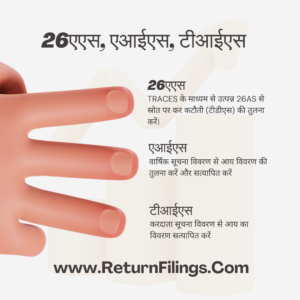1. Requirement of TDS on Sale and Purchase of Property
As per Section 194-IA of the Income Tax Act, 1961, Tax Deducted at Source (TDS) is applicable on the sale of immovable property. The buyer is required to deduct TDS when purchasing a property from the seller if the sale value exceeds a certain threshold.
The law intends to ensure that taxes are collected on the capital gains the seller might earn from the sale of the property, especially where the sale amount is high.
2. Types of Property Covered
TDS under Section 194-IA is applicable on:
- Residential property (flats, apartments, houses)
- Commercial property (shops, offices)
- Land (other than agricultural land)
TDS is not applicable to:
- Agricultural land located in rural areas as defined under Section 2(14) of the Income Tax Act. Rural agricultural land is exempt from the capital gains tax, hence no TDS is required.
3. Threshold Limit
- TDS applies when the consideration for the sale of immovable property exceeds ₹50 lakhs.
If the sale price of the property is less than ₹50 lakhs, no TDS is applicable.
4. Rate of TDS
- TDS is to be deducted at 1% of the sale consideration.
- In case the seller does not provide their PAN, the buyer must deduct TDS at 20%.
5. Time Limit for Depositing TDS
- The buyer must deposit the deducted TDS with the government within 30 days from the end of the month in which the deduction was made.
The TDS is to be deposited using Form 26QB (a challan-cum-statement) on the Income Tax Department’s website.
6. Details Required for TDS Deposit
When depositing TDS using Form 26QB, the following details are required:
- PAN of the buyer
- PAN of the seller
- Complete address of the property
- Transaction amount (consideration paid for the property)
- Date of transaction (date on which the property was transferred)
After submission, Form 16B (TDS certificate) should be generated by the buyer and provided to the seller within 15 days of filing Form 26QB.
7. Consequences of Delayed Filing of TDS
If TDS is not deducted on time or not deposited, interest is levied:
- 1% interest per month for delayed deduction
- 1.5% interest per month for delayed deposit after deduction
The interest is calculated from the date of deduction or from the date it should have been deducted.
8. Penal Provision for Not Deducting or Depositing TDS
- Penalty for non-deduction of TDS: As per Section 271C, a penalty equivalent to the amount of TDS not deducted may be imposed by the assessing officer.
- Penalty for non-deposit of TDS: A late fee under Section 234E is applicable at ₹200 per day until the TDS is filed, up to a maximum of the TDS amount. If TDS is not deposited even after deduction, prosecution may be initiated under Section 276B, which can lead to imprisonment for a term between 3 months and 7 years.
Example 1: Property Value Exceeding ₹50 Lakhs
- Scenario: Buyer Mr. A purchases a flat from Mr. B for ₹80 lakhs.
- TDS to be deducted: Mr. A needs to deduct 1% of ₹80 lakhs, i.e., ₹80,000.
- TDS Deposit: Mr. A must deposit the ₹80,000 within 30 days from the month of transaction, i.e., if the sale occurs on April 15th, the TDS should be deposited by May 30th.
Consequences of delay:
- If Mr. A fails to deposit the TDS by May 30th, he will be liable to pay interest at 1.5% per month until the amount is deposited.
Example 2: Property Value Below ₹50 Lakhs
- Example 2: Property Value Below ₹50 Lakhs
- TDS requirement: Since the sale value is below ₹50 lakhs, no TDS is required to be deducted or deposited.
Example 3: Seller Without PAN
- Scenario: Buyer Mr. X purchases an office space from Mr. Y for ₹60 lakhs. Mr. Y does not have a PAN.
- TDS to be deducted: In this case, Mr. X has to deduct TDS at 20%, which amounts to ₹12 lakhs (20% of ₹60 lakhs), due to the absence of Mr. Y’S PAN.
Example 4: Payment in Tranches for Property Purchase
Scenario: Mr. X purchases an under-construction apartment from a builder for ₹75 lakhs. The payment is structured in installments based on the construction milestones, and Mr. X makes the payments in 5 tranches as follows:
- ₹15 lakhs on booking
- ₹20 lakhs on the completion of the foundation
- ₹20 lakhs on the completion of the structure
- ₹10 lakhs on finishing
- ₹10 lakhs on possession
TDS Deduction: Mr. X is required to deduct 1% TDS on each installment.
- First tranche: On the booking payment of ₹15 lakhs, Mr. X should deduct TDS of ₹15,000 (1% of ₹15 lakhs).
- Second tranche: On the ₹20 lakhs paid upon foundation completion, TDS of ₹20,000 is to be deducted.
- And similarly, for all subsequent payments, Mr. X should deduct 1% TDS on each tranche.
TDS Deposit: Mr. X needs to deposit the TDS within 30 days of the end of the month in which each installment was paid. For example:
- The first tranche paid in April requires Mr. X to deposit the TDS by May 30th.
- The second tranche paid in June requires the TDS to be deposited by July 30th.
Form 26QB and Form 16B: Mr. X should file Form 26QB for each tranche and provide the builder with a TDS certificate (Form 16B) for each installment.
Example 5: Property Purchase with Loan Disbursement in Tranches
Scenario: Ms. Y purchases a property from a builder for ₹90 lakhs. She avails a home loan from a bank, which disburses the loan amount in stages as construction progresses. The bank disburses the following amounts:
- ₹30 lakhs on initial booking
- ₹30 lakhs after construction reaches 50%
- ₹30 lakhs on completion of the project
Even though the bank makes the payments directly to the builder, Ms. Y is responsible for ensuring TDS is deducted.
TDS Deduction: Ms. Y is required to deduct 1% TDS on each disbursement of the loan by the bank:
- On the first tranche of ₹30 lakhs, Ms. Y should deduct TDS of
₹30,000 (1% of ₹30 lakhs). - On the second tranche of ₹30 lakhs, she should deduct TDS of
another ₹30,000. - Similarly, for the third tranche of ₹30 lakhs, another ₹30,000 TDS
should be deducted.
TDS Deposit: Ms. Y needs to deposit the TDS with the government within 30 days of the end of the month when each installment is disbursed.
Bank Disbursement and TDS: Ms. Y should inform the bank about the requirement to deduct TDS, and she must handle the TDS payments, even if the bank transfers the full amount to the builder.
Form 26QB Filing: For each tranche, Ms. Y must file Form 26QB and deposit the deducted TDS with the Income Tax Department.
Example 6: Joint Property Purchase Using Loan
Scenario: Mr. A and Mrs. B, a married couple, jointly purchase a flat for ₹1.2 crore. They take a joint home loan, and the bank disburses the payment to the builder in two installments:
- ₹60 lakhs at the start of the project
- ₹60 lakhs upon completion
Since the sale consideration exceeds ₹50 lakhs, TDS needs to be deducted by both Mr. A and Mrs. B in proportion to their ownership share in the property.
Ownership Split: If Mr. A and Mrs. B are co-owners with equal 50-50 ownership, the TDS deduction obligation will be split equally.
TDS Deduction on First Tranche:
- Mr. A deducts ₹30,000 (1% of his share of ₹60 lakhs).
- Mrs. B deducts ₹30,000 (1% of her share of ₹60 lakhs).
TDS Deduction on Second Tranche:
- Mr. A deducts another ₹30,000 (1% of ₹60 lakhs).
- Mrs. B deducts another ₹30,000.
Separate Form 26QB: Both Mr. A and Mrs. B must file separate Form 26QB for each tranche, reflecting their respective TDS payments.
TDS Deposit: The TDS must be deposited by both co-owners within 30 days of the end of the month in which each payment is made.
Example 7: Purchase of a Property with Multiple Buyers
Scenario: Four individuals (Mr. P, Mr. Q, Mr. R, and Mr. S) jointly purchase a property worth %E2%82%B91.6 crore. They each have a 25% share in the property. The total amount is paid in two installments:
- ₹80 lakhs at the time of agreement
- ₹80 lakhs at the time of registration
Since each buyer’s individual share is ₹40 lakhs (which is below ₹50 lakhs), they are not required to deduct TDS on their portion. However, the total transaction value exceeds ₹50 lakhs, so TDS still applies.
TDS Deduction: Each buyer needs to deduct TDS for their share of the payment:
- On the first tranche of ₹80 lakhs, each buyer deducts 1% on their share of ₹20 lakhs (₹20,000 per buyer).
- On the second tranche of ₹80 lakhs, each buyer deducts 1% on their share of ₹20 lakhs (₹20,000 per buyer).
Separate Form 26QB: All four buyers must file individual Form 26QB for their respective portions of the property purchase
9. Conclusion
TDS on property transactions is a critical compliance requirement under the Income Tax Act. Buyers need to be vigilant in deducting TDS where applicable, ensuring timely deposits, and submitting necessary details to avoid penalties and interest charges. Failure to comply can lead to hefty financial penalties and even legal consequences. When property transactions involve payments in tranches or loan disbursements, the buyer (or joint buyers) must deduct TDS on each payment installment. The responsibility to ensure compliance with TDS regulations remains with the buyer, even when the loan provider disburses the funds. Failing to deduct or deposit TDS timely can lead to penalties, interest, and other consequences. The key is maintaining accuracy in the deduction, filing, and depositing TDS in line with the stages of payment.






